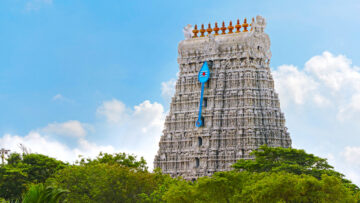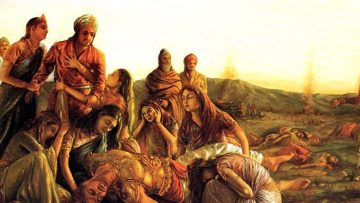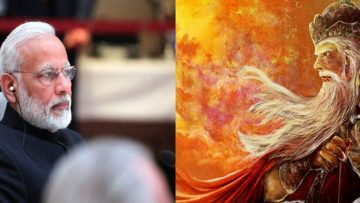(On July 19, 2025, Indica hosted the global online launch of Adṛsya: Hidden Marvels of the Mahābhārata, a volume curated and edited by Aditi Banerjee that revisited some of the forgotten and faintly remembered lives within the epic. Special Guest at the event, Gautam Chikermane, in his keynote address, approached the Mahābhārata not as epic alone, but as a field of civilisational inquiry. Grounded in puruṣārtha, he addressed the philosophical void of our time and the dimming clarity of a collective vision. The following address is a reflection of that moment…)
In the Mahabharata, individuals, communities, nations are all bound together with a goal that transcends the individual, the community, the nation. Dharma is the dominant means. Kama and Artha are the intermediate ways. And Moksha is the ultimate goal.
We can loosely examine the Mahabharata as a text that is clear about where it wants to go (moksha, or goal), how it wants to get there (kama and artha, or ways) and the vehicle it needs to travel (dharma, means). These three—goals, ways, and means—define what grand strategy is.
Every individual, every group is held to the test of this goal, this path, this means—Dhritarashtra and Yudhishthira, Drona and Drupada, Bhima and Duryodhana, Karna and Vikarna. Cumulatively, individuals and communities comprise their respective rashtra or janapada or nation. Extrapolating this thought, every country in the Mahabharata is culturally and compellingly but invisibly driven towards this highest goal.
Of course, there were smaller grand strategies, based on petty ambitions in the Mahabharata. The grand strategy of the Panchala stood on revenge as a goal, the marriage of Draupadi with the Pandavas as ways and other alliances as means. To Drupada, the loss of half his kingdom to Drona was a thorn that led him to a bleeding war. He had a tremendous Kama but misdirected Dharma.
The grand strategy of the Kuru stood on empire building and its defence. The support to Kauravas by institutions like Bhishma and Drona did not arise simply because of loyalty. There was a deeper purpose—the Kuru empire being controlled by the Panchalas, using Yudhishthira as a tool. In Dhritarashtra, the Kurus had some justification as empire builders, all of which stood smothered under the weight of Dhritarashtra’s and Duryodhana’s Kamas.
Another major pillar of grand strategy in the Mahabharata was Jarasandha, who had a good chance of expanding his empire, until Bhima killed him. He had a plan to bring Aryavarta under his control. Jarasandha had a huge Kama, adequate Artha, but a twisted means to suit his ambition, his goal—to sacrifice 100 kings to Shiva was clearly out of any ambit of Dharma.
But all three—Panchalas, Kurus and Magadhas—were small players in the larger conversation of Bharat. The strategic signature and the resultant coming together of kingdoms in the run up to the Kurukshetra was more fundamental. It was a war between centripetal forces that wanted smaller, independent nations on the one side; and centrifugal forces that sought a unifying umbrella within which to function. Again, the fight for this umbrella was between those who supported the Kauravas and those who fought for the Pandavas.
There was only one person who had a clear idea of the grand strategy of the time—Sri Krishna. He wanted to re-establish Dharma in Aryavarta—that was his goal. He saw in the Pandavas the possibilities to do so—the ways. All the alliances that signed up on the Pandava side were agencies—his means. And war, irrespective of the consequences it carried, was his institution of choice to deliver it.
In other words, I see the Mahabharata as a detailed account of a material-ethical-spiritual grand strategy of conflicting values expressed through statecraft.
But that time of Dwapara Yuga has passed.
We are in the middle of the Kali Yuga.
Humanity has given up on any higher grand strategy goal.
The manifestations of our problems have changed, but so has the spiritual aspiration.
Today, I see the current pressure on all of us as the clenching of the jaws of Kali Yuga. We are being crushed from all sides—economic, societal, religious, familial, technological, military, national, extremist, geopolitical. As a result, there is very little space for Moksha; it has been edged out of all mainstream discussions. Kama and Artha have become goals for the individual, the community and the nation alike. Dharma has been twisted to become a moral pretence—the European Union has perfected the art of this posturing (it pursues its interests while asking everyone else to follow its ‘values’). Moksha has been relegated as the luxury of the few.
In the modern lexicon of statecraft, grand strategy has been narrowed down, it has been devalued to a conversation of power and force between states. The ends, the ways and the means of grand strategy have become limited and exclusionary. They have become a zero-sum game—I win because you lose, I impose tariffs because I can and you are forced to accept, I break the rules-based international order because I’m powerful and you are not.
We have moved from a sophisticated abstraction that enriched the mundane-material to a point when routine has become the new dynamism, power has become a coarse ambition, and intimidation has become the vocabulary of international relations. In our quest to control power and wealth, we have become puppets in the hands of power and wealth.
The Mahabharata continues, but at the level of humanity, in the expressions of the masses, through the actions of leaders, it is devoid of a philosophical base necessary for growth. The fulfilment of the petty has become the highest aspiration of what we term civilisation in the 21st century. The Sattwic balance between dynamism and inertia, the pursuit of the material and the spiritual, has shifted base towards Rajasic or Tamasic affinities.
This is equally a reflection of who we are as individuals and as a people, as it is of national leaderships. A millennium from today, when we become ‘ancestors’ and our descendants look at their past, they would see our age as one of extreme barbarity wearing the garb of a limited and material reason.
Reason was supposed to enrich the physical—the mental being powering the physical being. But on that front, it has failed to upgrade itself to knowledge. As Sri Aurobindo puts it: “When we have passed beyond knowings, then we shall have Knowledge. Reason was the helper; Reason is the bar.” In our age, reason has become a hurdle in the hands of the few rather than a collaborator in the hands of the many.
Our descendants would see that although military conquests have reduced, imperialism through the weaponisation of technology, subjugations through the weaponisation of trade, and cultural invasions through the weaponisation of narratives continued. They would see how barbarism has shifted its weight from active war to an uncomfortable, simmering peace under which the fire of war burns. They would see something we don’t—the underlying barbarity that powered the age of wars has remained the same in the age of commerce.
They would see how the grand strategy of humanity shifted its base from purushartha to apurushartha. How we gave up on Dharma. How smaller ideas infected the mainstream and like viruses smothered our rich heritage. How the mind of the aggregate narrowed. How the vision couldn’t see beyond individual noses.
And when they do, they would wonder, just what happened between the time of Ved Vyasa and today, how we as a race, as a civilisation deteriorated, how we negotiated the transition into and out of the Kali Yuga. In their wonder, I am hoping they would have repaired the damage we have done.
So, what has our civilisation come to? I have three observations. First, in a me-first world, the harmonies of communities have given way to isolations of individuals. That bond between the individual soul and the collective soul that held a people together with values and had agency in its economics, its infrastructure, its festivities, its rituals has receded.
The only individuals who are united as communities are the unthinking and hyper-religious groups. They are able to steer, with physical violence, mental ferocity and moral outrage, the modern discourse. From the street to the state, they are the dominating force. They invade institutions, they scream the decimation of the ‘other’, they support hate and give moral authority to violence. They force societies to regress.
Technology was supposed to help unify the world, from the internet of the 1990s to social media of the 2010s, to artificial intelligence in 2025. So on the one hand technologies are taking us forward into newer and more exciting unknowns, followers of barbarity and violence are stealing from us the gains technology offers. The state is missing, the street is dominating.
Second, power has become the appellate authority—not justice, not fairness, not laws, rules, regulations, not ethics, and certainly not Dharma. Even in democracies, the will of the people has been hijacked within and outside. We see how the rise of China has gone rogue. How Russia is receding to wars. How the US continues to provoke and create new battlefields. How, since January 2025, the US is weaponising tariffs against other countries. The discourse of international relations has become an epidemic of aggression, coercion, force and war.
And third, philosophy has been co-opted, either directly into the barbarism of instant quenching, or indirectly through the barbarism of surface moralities, driven by preachy narratives that have no spiritual rigour. The most influential philosophers today are working in areas of feminism, critical race theory, political philosophy—not in tracking the evolution of man, the complexities of society, the emerging layers of grey amid the simplistic blacks and whites, the intersections of technology and robotics with human existence and serial demographic suicides.
The luxury of wealth and the titillation of narratives has become a necessity of life and new philosophers are busy aggregating political and social signals into ethical and moral treatises. From climate to welfare, security to peace, gender to religion, philosophers are lagging the actions of individuals, communities and nations. It’s almost like philosophy has decoupled itself from its very core—the understanding of existence, knowledge, values, reason, mind.
In all this, our planet has lost the grandest of all grand strategies. In its place, we now have narrow arcs that are limited to governments, dominated by security, underlined by economics. ‘Deal’ has become the new mantra. This is going to get worse in the next foreseeable three quarter centuries till 2100 A.D.
This is the intellectual, philosophical, dharmic challenge of our age. If there is one word that we can lean on and build such that individuals, communities and nations revert to harmony, it is: Fraternity.
Once we establish a new normal of peace and harmony, we need to rebuild our civilisational discourse towards fraternity. Without an inner fraternity, there can be no freedom, no equality, no unity. We may advocate the transient uniformity of processes, the fleeting uniformity of institutions, the half-life uniformity of ideas, but not the defining unity of souls.
Our challenge is not to copy-paste Ved Vyasa’s vision. It is to internalise it, isolate the eternal designs in it, apply them to our current state of evolution, society and even government. All of us gathered here need to express them through our thoughts, our writings, but most importantly our actions. We need to reimagine them for our age, reframe them for the Kali Yuga. We need to rise from the narrow confines of petty interests and rebuild a civilisational grand strategy for a fraternalised humanity. To borrow from the book being launched today, such a grand strategy is indeed the “hidden marvel of the Mahabharata”.
Given that all of you here have been touched by the Mahabharata, this is the message I wanted to give. We are privileged to have entered the universe called the Mahabharata. This privilege demands responsibility to shape a grand strategy of ideas that the future generations look up to.
My best wishes to all of you who have produced this book—the authors, the editor, Indica and the silent enabler of all these, Hari Kiran ji.
We are richer because of you.
(Note: Adṛsya: Hidden Marvels of the Mahābhārata, curated and edited by Aditi Banerjee, is available at:
https://www.amazon.in/Adrsya-Marvels-Mahabharata-Aditi-Banerjee/dp/9365477751/)
Disclaimer: The opinions expressed in this article belong to the author. Indic Today is neither responsible nor liable for the accuracy, completeness, suitability, or validity of any information in the article.











